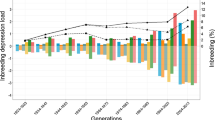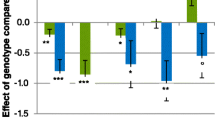Summary
Investigations on relationships between biochemical polymorphism and variation in quantitative traits are of interest from the perspectives of both theoretical quantitative genetics and practical animal breeding. This subject was studied by using racing performance records of more than 25,000 horses of the Swedish Trotter breed born in the period 1970–1979. For all horses data on six blood group and nine electrophoretic loci were available. Two different performance traits were investigated. A racing performance index value was calculated for all individuals which had started in at least five races. Horses which had not started at all or less than five times were pooled in an unstarted class and the proportion of started horses was analysed as an all-or-none trait. The relationships between the marker genes and these two performance traits were analysed statistically by using linear models. Analysis within sires revealed a very highly significant association between variation at the serum esterase locus (Es) and the proportion of started horses. In addition, four weakly significant associations were found. A striking feature of the highly significant association involving the esterase locus was that the effect of different alleles showed a good fit to an additive genetic model as the value of each heterozygous type was intermediate to the two corresponding homozygotes. In addition to the association tests, the possibility of genetic linkage between marker genes and genes affecting performance was tested as well as the influence on performance of heterozygosity at marker loci. No significant relationships were revealed in these latter tests.
Similar content being viewed by others
References
Andersson L (1983) Studies on genetic linkage in domestic animals with special reference to the horse. PhD Thesis, Swedish University of Agricultural Sciences, Uppsala
Andersson L, Sandberg K (1982) A linkage group composed of three coat color genes and three serum protein loci in horses. J Hered 73:91–94
Andersson L, Sandberg K (1984) Genetic linkage in the horse. 2. Distribution of male recombination estimates and the influence of age, breed and sex on recombination frequency. Genetics 106:109–122
Andersson L, Arnason Th, Sandberg K (1985) Studies on possible associations between genetic markers and racing performance in horses. Anim. Blood Groups Biochem Genet (Suppl 1) 16:90–91
Andresen E, Jensen P (1977) Close linkage established between the HAL locus for halothane sensitivity and the PHI (phosphohexose isomerase) locus in pigs of the Danish Landrace breed. Nord Vet Med 29:502–504
Arnason Th, Darenius A, Philipsson J (1982) Genetic selection indices for Swedish trotter broodmares. Livest Prod Sci 8:557–565
Beckmann JS, Soller M (1983) Restriction fragment length polymorphisms in genetic improvement: methodologies, mapping and costs. Theor Appl Genet 67:35–43
Bendroth M (1981) Orsaker till låg startfrekvens hos 2–4-åriga varmoch kallblodiga svenska travare. Department of Animal Breeding and Genetics, Swedish University of Agricultural Sciences, Uppsala (mimeograph in Swedish)
Briles WE, Stone HA, Cole RK (1977) Marek's disease: effects of B histocompatibility alloalleles in resistant and susceptible chicken lines. Science 195:193–195
Chakraborty R (1981) The distribution of the number of heterozygous loci in an individual in natural populations. Genetics 98:461–466
Cockerham CC, Weir BS (1983) Linkage between a marker locus and a quantitative trait of sibs. Am J Hum Genet 35:263–273
Eanes WF (1978) Morphological variance and enzyme heterozygosity in the monarch butterfly. Nature 276:263–264
Elston RC (1979) Major locus analysis for quantitative traits. Am J Hum Genet 31:655–661
Fisher RA, Scott AM (1978) Isoelectric focusing of horse serum esterase isozymes and detection of new phenotypes. Anim Blood Groups Biochem Genet 9:207–213
Geldermann H (1975) Investigations on inheritance of quantitative characters in animals by gene markers. 1. Methods. Theor Appl Genet 46:319–330
Geldermann H (1976) Investigations on inheritance of quantitative characters in animals by gene markers. 2. Expected effects. Theor Appl Genet 47:1–4
Geldermann H, Pieper U, Roth B (1985) Effects of marked chromosome sections on milk performance in cattle. Theor Appl Genet 70:138–146
Goodnight JH, Sall JP, Sarle WS (1982) The GLM procedure. In: SAS user's guide: statistics. Cary NC, SAS Institute, pp 139–199
Handford P (1980) Heterozygosity at enzyme loci and morphological variation. Nature 286:261–262
Hansen MP, Van Zandt JN, Law GRJ (1967) Differences in susceptibility to Marek's disease in chickens carrying two different B locus bloodgroup alleles. Poult Sc 46:1268
Harvey WR (1977) User's guide for LSML76. The Ohio State University, Columbus, Ohio, 76 pp
Hintz RL (1980) Genetics of performance in the horse. J Anim Sci 51:582–594
Jayakar SD (1970) On the detection and estimation of linkage between a locus influencing a quantitative character and a marker locus. Biometrics 26:451–464
Jensen EL, Smith C, Baker LN, Cox DF (1968) Quantitative studies on blood group and serum protein systems in pigs. 2. Effects on production and reproduction. J Anim Sci 27:856–862
Juneja RK, Gahne B, Edfors-Lilja I, Andresen E (1983) Genetic variation at a pig serum protein locus, PO-2 and its assignment to the Phi, Hal, S, H, Pgd linkage group. Anim Blood Groups Biochem Genet 14:27–36
Kennedy BW, Moxley JE, Saison R (1973) Some relationships between blood group factors and economic traits in swine. Can J Anim Sci 53:389–397
Kluge R, Geldermann H (1982) Effects of marked chromosome sections on quantitative traits in the mouse. Theor Appl Genet 62:1–4
Langlois B (1982) L'héritabilité des performances chez le Trotteur. Une revue bibliographique. Ann Genet Sel Anim 14:399–414
Leary RF, Allendorf FW, Knudsen KL (1983) Developmental stability and enzyme heterozygosity in rainbow trout. Nature 301:71–72
Lerner IM (1954) Genetic homeostasis. Oliver and Boyd, Edinburgh
McAndrew BJ, Ward RD, Beardmore JA (1982) Lack of relationship between morphological variance and enzyme heterozygosity in the plaice, Pleuronectes platessa. Heredity 48:117–125
Mitton JB (1978) Relationship between heterozygosity for enzyme loci and variation of morphological characters in natural populations. Nature 273:661–662
Neimann-Sørensen A, Robertson A (1961) The association between blood groups and several production characteristics in three Danish cattle breeds. Acta Agric Scand 11:163–196
Rasmusen BA (1981) Linkage of genes for PHI, halothane sensitivity, A-O inhibition, H red blood cell antigen and 6-PGD variants in pigs. Anim Blood Groups Biochem Genet 12:207–209
Rendel J (1959) A study on relationships between blood group and production characters in cattle. In: Rep 6th Int Congr Blood Group Res in Animals. Munich, pp 8–23
Ryman N, Lagercrantz U, Andersson L, Chakraborty R, Rosenberg R (1984) Lack of correspondence between genetic and morphologic variability patterns in Atlantic herring (Clupea harengus). Heredity 53:687–704
Sandberg K, Andersson L (1984) Genetic linkage in the horse. 1. Linkage relationships among 15 blood marker loci. Herditas 100:199–208
Scott AM (1972) Improved separation of polymorphic esterases in horses. In: Proc 12th Eur Conf Anim Blood Groups Biochem Polymorphism. Budapest, pp 551–553
Smith CAB (1975) A non-parametric test for linkage with a quantitative character. Ann Hum Genet 38:451–460
Sokal RR, Rohlf FJ (1981) Biometry, 2nd edn. WH Freeman, San Francisco
Soller M (1974) Methods for the detection of linkage between a marker gene and a linked polygene affecting a quantitative trait. In: Proc 1st World Congr Genet Applied to Livestock Prod 3:284–294
Soller M, Beckmann JS (1982) Restriction fragment length polymorphisms and genetic improvement. In: Proc 2nd World Congr Genet Applied to Livestock Prod 6:396–404
Soller M, Beckmann JS (1983) Genetic polymorphism in varietal identification and genetic improvement. Theor Appl Genet 67:25–33
Soller M, Genizi A (1978) The efficiency of experimental designs for the detection of linkage between a marker locus and a locus affecting a quantitative trait in segregating populations. Biometrics 34:47–55
Soller M, Brody T, Genizi A (1976) On the power of experimental designs for the detection of linkage between marker loci and quantitative loci in crosses between inbred lines. Theor Appl Genet 47:35–39
Soulé ME (1980) Thresholds for survival: maintaining fitness and evolutionary potential. In: Soulé ME, Wilcox BA (eds) Conservation biology. Sinauer Associates, Massachusetts
Tanksley SD, Medina-Filho H, Rick CM (1982) Use of naturally-occurring enzyme variation to detect and map genes controlling quantitative traits in an interspecific backcross of tomato. Heredity 49:1–25
Thoday JM (1961) Location of polygenes. Nature 191:368–370
Thoday JM (1979) Polygene mapping: uses and limitations. In: Thompson JN, Thoday JM (eds) Quantitative genetic variation. Academic Press, New York, pp 219–233
Thompson JN Jr (1975) Quantitative variation and gene number. Nature 258:665–668
Tolley EA, Notter DR, Marlowe TJ (1985) A review of the inheritance of racing performance in horses. Anim Breed Abstr 53:163–185
Weitkamp LR, Andersson L (1984) Linkage groups of the horse (Equus Caballus). Genet Maps 3:390–391
Zwiauer D (1980) Beziehungen zwischen biochemischen Markergenen und Leistungseigenschaften beim Rind. Fortschr Tierzucht Züchtungsbiol, vol 2. Parey, Hamburg Berlin
Author information
Authors and Affiliations
Additional information
Communicated by R.Riley
Rights and permissions
About this article
Cite this article
Andersson, L., Arnason, T. & Sandberg, K. Biochemical polymorphism in relation to performance in horses. Theoret. Appl. Genetics 73, 419–427 (1987). https://doi.org/10.1007/BF00262510
Accepted:
Issue Date:
DOI: https://doi.org/10.1007/BF00262510




